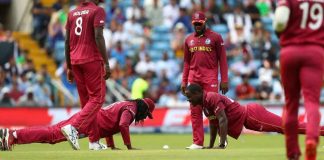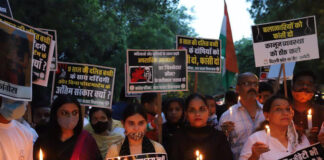JANUARY 1, 2018
 In this Jan. 1, 2018, file photo provided by the North Korean government, North Korean leader Kim Jong Un delivers his New Year’s speech at an undisclosed place in North Korea. | Photo Credit: AP
In this Jan. 1, 2018, file photo provided by the North Korean government, North Korean leader Kim Jong Un delivers his New Year’s speech at an undisclosed place in North Korea. | Photo Credit: AP
Kim’s speech was closely watched as North Korean leaders traditionally use New Year’s statements to reflect on the past year and issue major policy goals for the year ahead.
North Korean leader Kim Jong Un said on Tuesday he hopes to extend his high-stakes nuclear summitry with President Donald Trump into 2019, but also warns Washington not to test North Koreans’ patience with sanctions and pressure.
During his televised New Year’s speech, Mr. Kim said he’s ready to meet Mr Trump at any time to produce an outcome “welcomed by the international community.” However, he said the North will be forced to take a different path if the United States “continues to break its promises and misjudges the patience of our people by unilaterally demanding certain things and pushes ahead with sanctions and pressure.”
Mr. Kim also said the United States should continue to halt its joint military exercises with ally South Korea and not deploy strategic military assets to the South. He also made a nationalistic call urging for stronger inter-Korean cooperation and said the North is ready to resume operations at a jointly run factory park in the North Korean border town of Kaesong and restart South Korean tours to the North’s Diamond Mountain resort. Neither of those is possible for South Korea unless sanctions are removed.
Some analysts say North Korea has been trying to drive a wedge between Washington and Seoul while putting the larger burden of action on the United States. Pyongyang over the past months has accused Washington of failing to take corresponding measures following the North’s unilateral dismantlement of a nuclear testing ground and suspension of nuclear and long-range missile tests.
Washington and Pyongyang are trying to arrange a second summit between Mr. Trump and Mr. Kim, who met in Singapore on June 12.
“If the United States takes sincere measures and corresponding action to our leading and pre-emptive efforts, then [U.S.-North Korea] relations will advance at a fast and excellent pace through the process of implementing [such] definite and groundbreaking measures,” said Mr. Kim, who delivered the speech sitting on a leather chair, wearing a black suit and gray-blue tie.
“It is the unwavering position of our party and the republic’s government and my firm will that the two countries as declared in the June 12 joint statement … take steps to establish a permanent and stable peace regime and push toward the complete denuclearization of the Korean Peninsula,” he said. “Therefore, we have declared domestically and internationally and took various actions showing our commitment that we will no longer create and test nuclear weapons and will not use or spread them.”
Mr. Kim hailed the results of the North’s diplomatic activities in 2018, including his three meetings with South Korean President Moon Jae-in. Mr. Kim said an inter-Korean military agreement reached in their last summit in September to reduce conventional military threats was “realistically a non-aggression declaration.”
Mr. Kim also emphasized the development of the North Korean economy and, without elaborating, mentioned nuclear power as part of the country’s plans to boost electricity production.
Mr. Kim’s speech was closely watched as North Korean leaders traditionally use New Year’s statements to reflect on the past year and issue major policy goals for the year ahead.
Mr. Kim used his New Year’s speech a year ago to start a newfound diplomatic approach with Seoul and Washington, which led to his meetings with Mr. Moon and Mr. Trump. Mr. Kim also met three times with Chinese President Xi Jinping, which boosted his leverage by reintroducing Beijing Pyongyang’s main ally as a major player in the diplomatic process to resolve the nuclear standoff.
But nuclear talks between Washington and Pyongyang have stalled in recent months as they struggle with the sequencing of North Korea’s disarmament and the removal of U.S.-led sanctions against the North.
The North has also bristled at U.S. demands to provide a detailed account of nuclear and missile facilities that would be inspected and dismantled under a potential deal.
The hardening stalemate has fueled doubts on whether Mr. Kim will ever voluntarily relinquish the nuclear weapons and missiles he may see as his strongest guarantee of survival. In his meetings with Mr. Trump and Mr. Moon, Mr. Kim signed vague statements calling for the “complete denuclearization” of the Korean Peninsula without describing when and how it would occur.
But North Korea for decades has been pushing a concept of denuclearization that bears no resemblance to the American definition, with Pyongyang vowing to pursue nuclear development until the United States removes its troops and the nuclear umbrella defending South Korea and Japan. The North used a blunt statement last month reiterated its traditional stance on denuclearization, saying it will never unilaterally give up its weapons unless Washington removes what Pyongyang describes as a nuclear threat.
The statement jarred with Seoul’s claim that Mr. Kim is genuinely interested in negotiating away his nukes and suggested that the North will potentially demand the United States withdraw or significantly reduce the 28,500 American troops stationed in South Korea, a major sticking point in any disarmament deal.
Some analysts say it’s becoming clear the North intends to keep a nuclear arsenal and turn the talks with the United States into a bilateral arms reduction negotiation between two nuclear states, rather than a unilateral process of surrendering its arsenal.
Washington and Pyongyang have yet to reschedule a meeting between U.S. Secretary of State Mike Pompeo and senior North Korean officials after the North canceled it at the last minute in November. There are views that North Korea wants a quick second summit because it thinks it can win major concessions from Trump that they probably couldn’t from lower-level U.S. officials, who are more adamant about the North committing to inspections and verification.
Courtesy/Source: AP









































































































